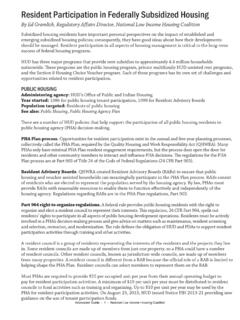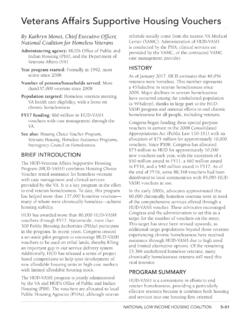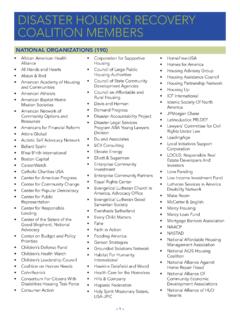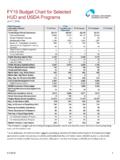Transcription of Emergency Rental Assistance (ERA) During the Pandemic ...
1 Research Brief | March 2022. Emergency Rental Assistance (ERA). During the Pandemic : Implications for the Design of Permanent ERA Programs housing Initiative at Penn National Low Income housing Coalition Claudia Aiken Andrew Aurand Isabel Harner Rebecca Yae Vincent Reina In retrospect, what do you think could have Several administrators emphasized the high stakes been done differently in implementing your involved: jurisdiction's ERA program? . This is the question we posed in a national survey We have done the best we can given the of Emergency Rental Assistance (ERA) program [necessary] speed, [with the] budget and administrators at the end of 2021, asking them to tools at our disposal. In retrospect, we would reflect on the experience of creating and implementing do a lot of things differently, but there was no programs meant to keep millions of vulnerable renters time for trial and error.. housed amidst a global Pandemic .
2 The responses we received highlight the recurring challenges . limited capacity, difficulty enrolling both tenants The lessons ERA administrators have learned over and landlords, and complex and constantly evolving the course of program implementation are critical to federal guidance that ERA programs face. They also future efforts to protect renters in unexpected crises. speak to the strategies some administrators adopted In this research brief, we present the results of our to address these challenges, including creative most recent national survey of ERA programs, as well staffing and partnerships, targeted outreach, flexible as trends that emerge from our three previous surveys applications, and direct-to-tenant payments. and case study work, to unpack these lessons. Introduction Emergency Rental At the same time, there is an opportunity to think about longer-term policy solutions to promote housing stability, including In the two years since the COVID-19 Pandemic began, committing to permanent Emergency Rental Assistance states, localities, and tribal entities across the country to protect renters facing sudden financial shocks.
3 Have launched and administered ERA programs to assist households struggling to pay These Millions of renters were one unexpected crisis away programs have disbursed billions of dollars to eligible from severe housing instability even before the onset households, primarily using federal funds but also of ERA programs helped to keep some of using local and philanthropic Along the way, them housed During the Pandemic , but these programs programs have evolved as some ERA administrators are largely temporary. A return to normal means that built up capacity and infrastructure, learned from their many renter households will continue to face frequent successes and failures, and responded to adjustments or forced moves, poor housing conditions, and other in federal policy and to new funding streams. forms of instability with no safety net. Our research has documented this evolution through With Treasury ERA money running out, and without a a series of four national surveys of ERA program permanent solution to replace it, the infrastructure that administrators and case studies of 15 early ERA jurisdictions created to operate their programs is at programs.
4 In this report, we draw on the fourth and risk of being dismantled and important lessons learned final survey, as well as our cumulative research, to are at risk of being lost. How can policymakers build highlight the challenges and changes that have shaped on the infrastructure and insights of the past two years Emergency Rental Assistance programs. We end with to stabilize renters going forward? implications for future policy. 5 Census Bureau. Week 42 Household Pulse Survey Public Use File (PUF). January 26-February 7, This report arrives at a critical moment. Some state 2022. and local programs using Department of the 6 Seventy percent of the nation's million extremely low-income renter households were severely Treasury (Treasury) ERA funds are no longer accepting housing cost-burdened as of 2019. Severe housing cost burdens combined with meager savings leave applicants, having run out or being at risk of running out households extremely vulnerable to shocks in income.
5 See National Low Income housing Coalition. The Gap: A Shortage of Affordable Homes. March 2021. of , 4 Yet renters continue to face challenges: approximately 11 million households reported low confidence in their ability to pay next month's rent, as of February 7, 2022, and approximately 2 million households had applied for but were still waiting for 1 As of February 28, 2022, NLIHC ERA databases contain more than 1,130 ERA programs created or expanded in response to the Pandemic , including 512 programs funded through the Treasury ERA. program and 621 early programs funded in a variety of ways, including the CARES Act. Most early programs had limited funding and have since closed. 2 As of February 28, 2022, the NLIHC Treasury ERA Spending Tracker notes that Treasury ERA programs alone had obligated or expended over $21 billion. 3 Vincent Reina. Rental Assistance is a Lifeline for Thousands of Philadelphia Renters - Don't Let It Disappear, Philadelphia Inquirer.
6 January 31, 2022. 4 Sophie Kasakove and Glenn Thrush. Federal Rental Assistance is Running Out, With Tenants Still in Need, New York Times. January 9, 2022. 2. Methods Third, we use the results of our fourth and final survey to explore the adjustments Treasury ERA programs made or will make as they transition(ed) between The early ERA programs that launched in 2020, when ERA1 and ERA2, two important federal funding COVID-19 first struck the , used a variety of streams with slightly different federal guidance. funding streams, including funds from the CARES Finally, we rely on open-ended responses to a Act. Our first survey, in August-October 2020, retrospective question asked in the final survey to received responses from 220 of these early programs. better understand what aspects of their programs We followed up with 15 of them to conduct in-depth administrators would have changed, but didn't or case studies. Our next three surveys gathered responses couldn't, given what they know now.
7 From administrators of Treasury ERA programs, which use the $ billion Congress enacted specifically for Emergency Rental Assistance , housing stability services, It is important to note that this brief does not evaluate and other housing expenses in the Consolidated the ability of ERA programs to serve tenants and Appropriations Act of 2020 (Treasury ERA1) and the landlords in a timely, equitable, and effective way. American Rescue Plan Act (Treasury ERA2). A total Much more research is needed to understand access to of 64 program administrators responded to our Spring ERA programs as well as the impact of Assistance on 2021 survey, 105 responded to our Summer 2021 household outcomes. survey, and 100 responded to our final survey in late 2021. These surveys captured responses from program administrators as they initially implemented their programs, adapted their programs, and transitioned between Treasury ERA1 and Treasury ERA2 funding streams.
8 While each survey captured a broad cross- section of programs, the surveys for the most part do not track the same programs over time. Twenty-eight programs responded to both our first survey in 2020. and our last survey in late 2021. This report investigates how ERA programs changed over time, with respect to both their challenges and their practices, in four ways: First, we compare responses from the full samples of our surveys. In most cases, we compare responses from 2020 early ERA program administrators surveyed between August and October 2020 to those of 100 Treasury ERA administrators surveyed approximately a year later, between October and December 2021. Second, we examine the 28 programs surveyed in August-October 2020 that also responded in October-December 2021 to understand how individual programs may have adapted. 3. Figure 01. Change in Challenges Over the Course of 2021 (Oct-Dec 2021, N = 95). 46%. 40% 37%.
9 30%. 20% 17%. 10%. 0%. Increased Decreased No Change or Fluctuated Key Challenges and Strategies four surveys, cited limited staff capacity as a challenge (see Figure 2 on the following page). In our final survey, we asked survey respondents to Technology was another consistent and common reflect on how their program challenges had shifted challenge, cited by 47% of Treasury ERA programs in over the past year. A striking 37% (N=95) reported the Spring of 2021, by 41% of programs in Summer that their challenges had increased over the past 2021, and by 35% in late 2021. year (Figure 1). Nearly half (46%) of respondents reported that their challenges had decreased and a Treasury ERA programs also faced ongoing smaller share (17%) responded that their challenges challenges with tenant and landlord responsiveness, had done something other than increase or decrease. and our surveys suggest these challenges may have Almost all respondents who selected other (92%, become more prevalent over time.)
10 Our first survey N=14) indicated that their challenges had either asked about incomplete applications rather than remained constant or had fluctuated over time, but tenant responsiveness. Seventy-one percent (N=139). not necessarily increased or decreased. In sum, over of early ERA respondents to our 2020 survey cited half of survey respondents (54%, N=95) indicated that incomplete applications as a challenge. Of the survey their challenges did not decrease over the course of respondents who identified challenges in 2021, tenant 2021. (un)responsiveness was identified by 56% in Spring 2021, 62% in Summer 2021, and 74% in late 2021. Despite shifts in program design and implementation, Landlord (un)responsiveness was cited by 44% of ERA program administrators identified a similar set Treasury ERA survey respondents in Spring 2021, of challenges in each of the four surveys administered 67% of respondents in Summer 2021, and 74% of between 2020 and late 2021.













